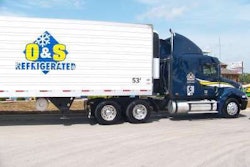Increases in truck weight and length would have a direct beneficial effect on the challenges facing American businesses, according to a study conducted by the University of Michigan Transportation Research Institute that was commissioned by the National Private Truck Council.
Specifically, the study’s findings implied that significant improvements could be achieved in fuel consumption, cost, congestion, improved distribution efficiency and driver availability by increasing the gross vehicle weight (GVW) up to 97,000 pounds on a six-axle tractor-semitrailer from its current 80,000-pound maximum while at the same time boosting cubic capacity through the use of LCVs (specifically, two 53-foot trailers, or “turnpike doubles”).
“For more than a decade, NPTC has supported modification of federal truck size and weight restrictions in a manner that will improve shipper and carrier productivity,” says Gary Petty, NPTC president and chief executive officer. “While there has been ample anecdotal evidence in the private fleet community that larger trucks would mean greater productivity for the businesses operating them, there has not been, until now, a study that helps support the case for changes in the law based on an independent research analysis of a sample group of companies.”
The final report, “Analysis of the Potential Benefits of Larger Trucks for U.S. Businesses Operating Private Fleets,” estimates a reduction in truck loads of 10 percent if the allowable weight was increased and 6 percent if LCVs were permitted; if both strategies were implemented, then the estimated reduction in truck loads from the members surveyed would be 16 percent.
The anticipated gains from increases in weight and length would be primarily from the cost of operations and vehicle miles traveled, though some companies also will gain from improved customer service, product mix and reduced time to market, according to the study.
“The major potential operating cost benefit of increased tractor-trailer weight or length would be reduced diesel fuel consumption from needing fewer shipments, either because a trailer that now weighs out could carry more cargo, or a company whose trailers frequently cube out could add a second trailer,” according to the UMTRI report. “The reduction in miles per gallon due to heavier or longer trucks would be greatly offset by the significant improvement in transport efficiency (amount of fuel used per cargo unit transported) and the reduction in total miles driven from making fewer shipments.”
Finally, the study concluded that fewer shipments would result in less traffic congestion, less fuel consumption and fewer emissions, particularly carbon dioxide (CO2), resulting from fewer truck trips, less congestion and fewer hours of idling. For the five companies in the study that could benefit from additional cargo weight of 14,000 pounds (97,000 GVW), their total annual fuel reduction is estimated at 10.8 million gallons, which would result in a reduction of 240 million pounds (120,000 tons) of CO2; for the three companies that would benefit from LCVs and would consume 23.8 million fewer gallons, it would be 528 million pounds (264,000 tons).
If the fuel consumption and emissions reduction benefits estimated for this study’s subset of vehicle fleets were representative of the national class 8 truck fleet, then the national annual diesel fuel reduction would be nearly three billion gallons and the amount of CO2 produced would be reduced by more than 65.3 billion pounds (32.6 million tons).
Legislators in Congress are lining up on one side of the truck size and weight issue or the other. Sen. Frank Lautenberg (D-N.J.) and Rep. James McGovern (D-Mass.) introduced legislation (S. 779, H.R. 1618) that would extend the current limit of 80,000 pounds and maximum length of 53 feet for tractor-trailer trucks on interstate highways to the National Highway System. The NHS covers some 160,000 miles of highway, while interstates represent 44,000 miles. Within the trucking community, the Owner-Operator Independent Drivers Association and the International Brotherhood of Teamsters are backing the Lautenberg-McGovern bill, citing safety and infrastructure concerns.
On the other side is legislation (H.R. 1799) introduced by Reps. Michael Michaud (D-Maine) and Jean Schmidt (R-Ohio) that would authorize states to allow trucks with a gross weight of up to 97,000 pounds to operate on interstate highways within their state provided that trucks operating above 80,000 pounds add a sixth axle, with brakes. In addition, heavier vehicles would pay a fee that would be dedicated to bridge investments in states that authorize their use. The American Trucking Associations supports H.R. 1799, saying it could allow trucking companies to use more efficient vehicles to deliver more freight while making fewer trips. The result, ATA says, would be fewer crashes, less fuel burned, less congestion and reduced carbon and toxic emissions.
Legislation introduced today, May 14, would increase the proportion of national freight transportation provided by modes other than trucks by 10 percent by 2020. Sens. Frank Lautenberg (D-N.J.) and Jay Rockefeller (D-W.Va.) introduced the Federal Surface Transportation Policy and Planning Act of 2009, which they say is aimed at establishing a unifying and comprehensive strategy for the U.S. surface transportation system. The measure also targets reducing per-capita motor vehicle miles traveled on an annual basis, reducing surface transportation-generated CO2 levels 40 percent by 2030, and reducing motor vehicle-related deaths 50 percent by 2030.













